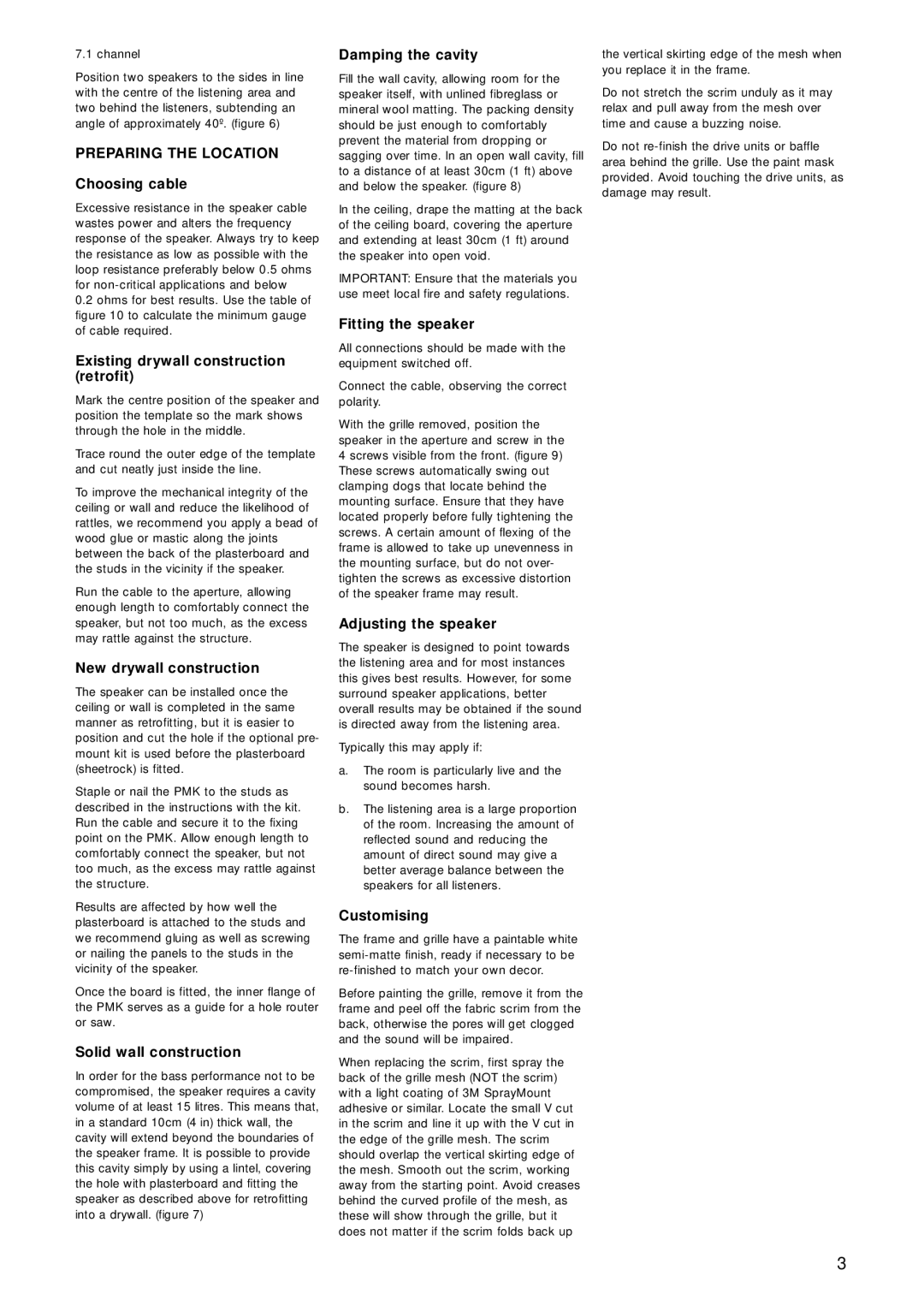7.1 channel
Position two speakers to the sides in line with the centre of the listening area and two behind the listeners, subtending an angle of approximately 40º. (figure 6)
PREPARING THE LOCATION
Choosing cable
Excessive resistance in the speaker cable wastes power and alters the frequency response of the speaker. Always try to keep the resistance as low as possible with the loop resistance preferably below 0.5 ohms for
0.2ohms for best results. Use the table of figure 10 to calculate the minimum gauge of cable required.
Existing drywall construction (retrofit)
Mark the centre position of the speaker and position the template so the mark shows through the hole in the middle.
Trace round the outer edge of the template and cut neatly just inside the line.
To improve the mechanical integrity of the ceiling or wall and reduce the likelihood of rattles, we recommend you apply a bead of wood glue or mastic along the joints between the back of the plasterboard and the studs in the vicinity if the speaker.
Run the cable to the aperture, allowing enough length to comfortably connect the speaker, but not too much, as the excess may rattle against the structure.
New drywall construction
The speaker can be installed once the ceiling or wall is completed in the same manner as retrofitting, but it is easier to position and cut the hole if the optional pre- mount kit is used before the plasterboard (sheetrock) is fitted.
Staple or nail the PMK to the studs as described in the instructions with the kit. Run the cable and secure it to the fixing point on the PMK. Allow enough length to comfortably connect the speaker, but not too much, as the excess may rattle against the structure.
Results are affected by how well the plasterboard is attached to the studs and we recommend gluing as well as screwing or nailing the panels to the studs in the vicinity of the speaker.
Once the board is fitted, the inner flange of the PMK serves as a guide for a hole router or saw.
Solid wall construction
In order for the bass performance not to be compromised, the speaker requires a cavity volume of at least 15 litres. This means that, in a standard 10cm (4 in) thick wall, the cavity will extend beyond the boundaries of the speaker frame. It is possible to provide this cavity simply by using a lintel, covering the hole with plasterboard and fitting the speaker as described above for retrofitting into a drywall. (figure 7)
Damping the cavity
Fill the wall cavity, allowing room for the speaker itself, with unlined fibreglass or mineral wool matting. The packing density should be just enough to comfortably prevent the material from dropping or sagging over time. In an open wall cavity, fill to a distance of at least 30cm (1 ft) above and below the speaker. (figure 8)
In the ceiling, drape the matting at the back of the ceiling board, covering the aperture and extending at least 30cm (1 ft) around the speaker into open void.
IMPORTANT: Ensure that the materials you use meet local fire and safety regulations.
Fitting the speaker
All connections should be made with the equipment switched off.
Connect the cable, observing the correct polarity.
With the grille removed, position the speaker in the aperture and screw in the 4 screws visible from the front. (figure 9) These screws automatically swing out clamping dogs that locate behind the mounting surface. Ensure that they have located properly before fully tightening the screws. A certain amount of flexing of the frame is allowed to take up unevenness in the mounting surface, but do not over- tighten the screws as excessive distortion of the speaker frame may result.
Adjusting the speaker
The speaker is designed to point towards the listening area and for most instances this gives best results. However, for some surround speaker applications, better overall results may be obtained if the sound is directed away from the listening area.
Typically this may apply if:
a.The room is particularly live and the sound becomes harsh.
b.The listening area is a large proportion of the room. Increasing the amount of reflected sound and reducing the amount of direct sound may give a better average balance between the speakers for all listeners.
Customising
The frame and grille have a paintable white
Before painting the grille, remove it from the frame and peel off the fabric scrim from the back, otherwise the pores will get clogged and the sound will be impaired.
When replacing the scrim, first spray the back of the grille mesh (NOT the scrim) with a light coating of 3M SprayMount adhesive or similar. Locate the small V cut in the scrim and line it up with the V cut in the edge of the grille mesh. The scrim should overlap the vertical skirting edge of the mesh. Smooth out the scrim, working away from the starting point. Avoid creases behind the curved profile of the mesh, as these will show through the grille, but it does not matter if the scrim folds back up
the vertical skirting edge of the mesh when you replace it in the frame.
Do not stretch the scrim unduly as it may relax and pull away from the mesh over time and cause a buzzing noise.
Do not
3
